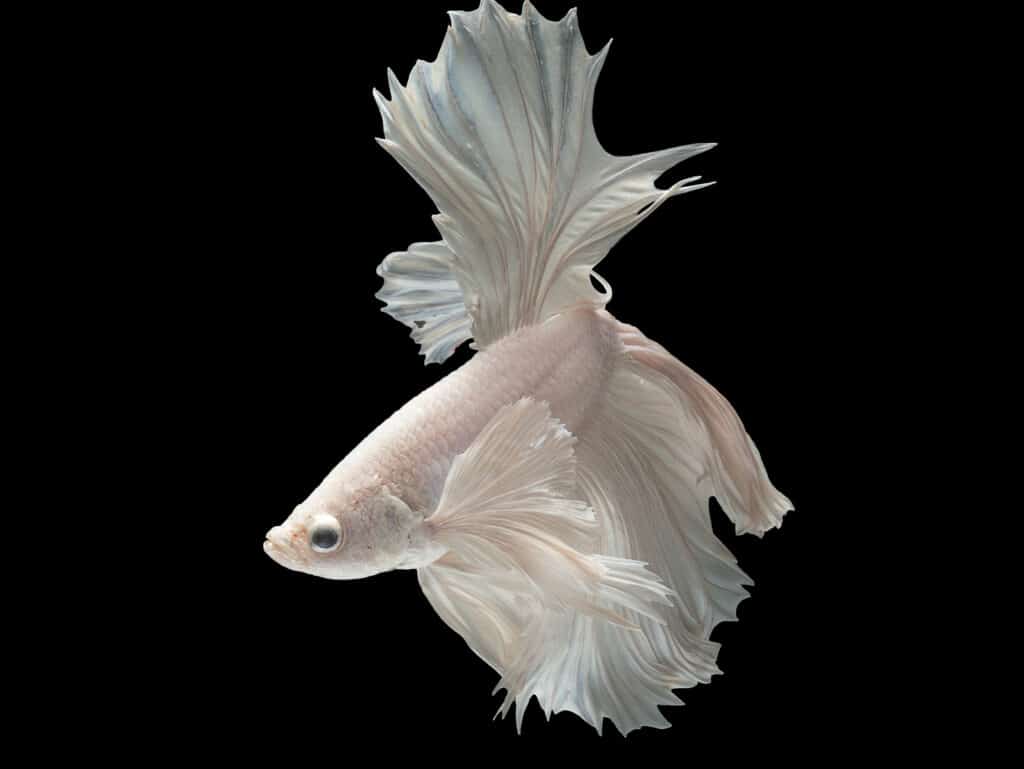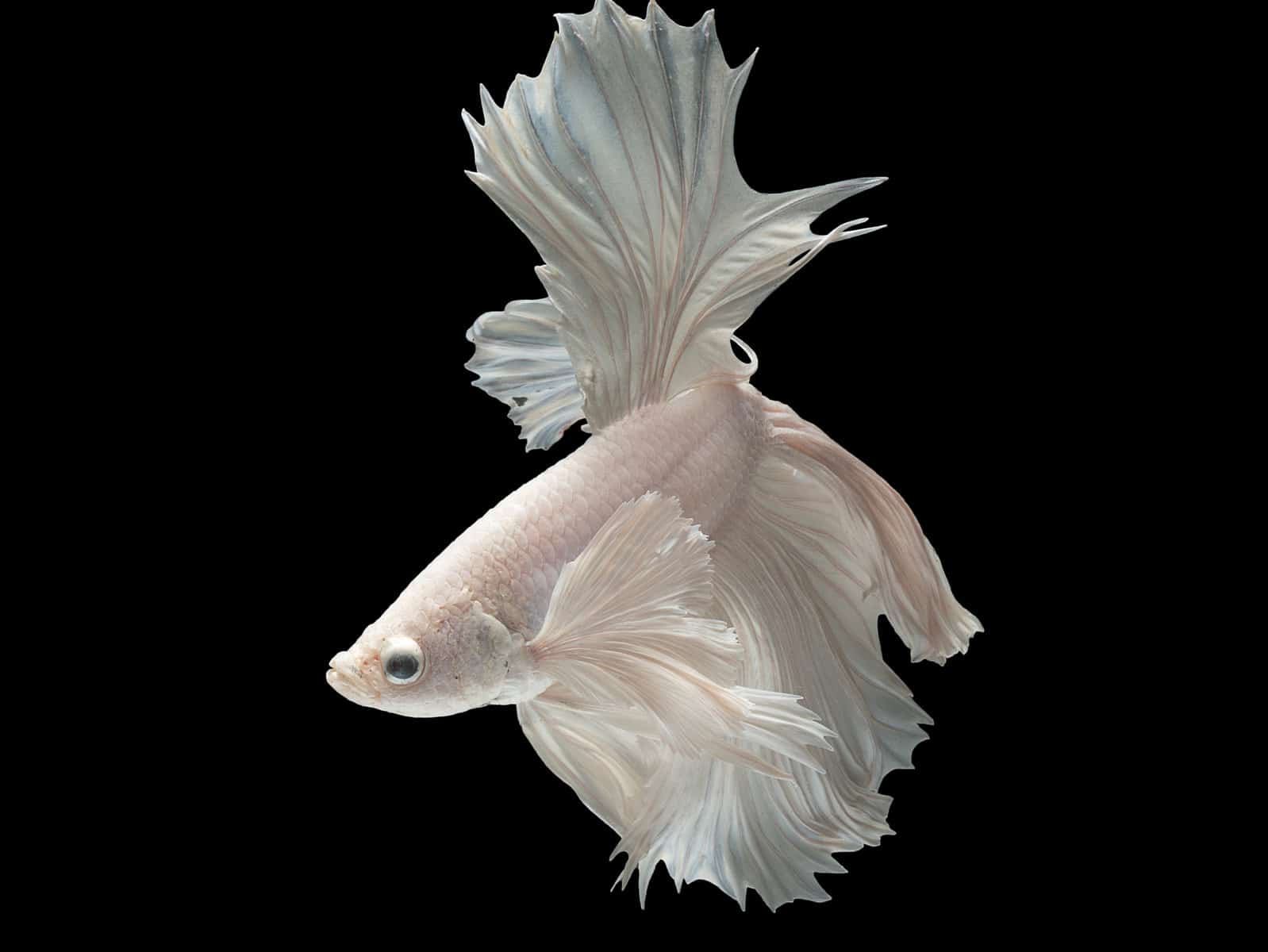%If you have been searching for the perfect Betta Fish type for your aquarium, the White Elephant Ear Betta may just be for you. Elephant Ear Betta, also known as Dumbo Bettas, got their name from the large fins on the sides of their heads shaped like elephant ears. This complete care guide will tell you everything you need to know about caring for this unique tropical fish.
White Elephant Ear Betta – Summary
| White Elephant Ear Betta Info | |
|---|---|
| Common Names | Dumbo Betta, White Opal Betta |
| Scientific Name | Betta Splendens |
| Size | 2.5 to 3.5 inches |
| Minimum Tank Size | 10 to 20 gallons |
| Beginner-friendly | No |
| Lifespan | Up to 10 years, usually 3-5 years |
| Diet | Omnivore but primarily carnivorous |
| Aggressive | Yes |
| Water temperature | 72° to 82°F |
| pH level | pH 6 to 8 |
| Water hardness | 3 to 4 dGH |
White Elephant Ear Betta Origins
The white elephant ear betta is one of 3 types of bettas with large fins resembling elephant ears. This specific variety of fish is native to Vietnam and Thailand in Asia.
What Does the White Elephant Ear Betta Look Like?
The Elephant Ear Betta has characteristics that make it different from other bettas. The main difference lies in its large pectoral fins resembling elephant ears. Elephant ear bettas also have an array of bright colors like many other bettas.
Elephant Ear Betta Size
The average size of this betta is around 2.5 inches in length, although they can reach up to 3.5 inches. Male bettas tend to be larger than females and have more prominent fins. Due to their flowing fins, they seem bigger than their actual body size.
Elephant Ear Betta Lifespan
Elephant Ear Bettas can easily live 3-5 years when kept in a well-maintained environment, but they have been known to live up to 10 years. Meeting your betta’s food and living conditions requirements will greatly affect the longevity of your pet fish.
Elephant Ear Betta Behavior
Just like any betta, the disposition of your Elephant Ear Betta varies, but these are typically aggressive fish by nature.
Males tend to be more aggressive than females, so it isn’t a good idea to have more than one male in the same tank. Female betta fish can be safely placed in the same tank.
Tank Requirements
Although bettas are hearty aquarium fish, they need room to thrive. For healthy fish, starting with at least a 20-gallon tank is recommended.
Smaller tanks can lead to health issues and, eventually, death. The minimum requirement for one betta fish is a 5-gallon fish tank. Here are some popular choices if you’re looking for the best tank.
Tank Shape
Elephant Ear Bettas prefer living in a longer tank. In the wild, Bettas live in shallow water types like rice paddies. A larger tank also allows them to swim freely. Using a larger betta fish tank can also prevent aggression by giving the fish more space.
Ideal Water Temperature
Elephant Ear Bettas are tropical fish from Asia which means they prefer warmer water. The ideal water temperature is between 72 to 82 degrees Fahrenheit. If you need to change the tank water, check the water often to make sure it is in the temperature range. Sudden changes in water temperature can shock your betta.
Ideal Water PH
The ideal water PH to keep your fish healthy is 6 to 8. The tank water should be changed at least once weekly to ensure that there is plenty of fresh water.
Tank Filtration
Your Betta tank environment will definitely need a filter. Poor water quality can lead to health issues like infections and fish death. Using a filter helps you to stop the buildup of residue.
Even though a filter is necessary, it’s important to avoid a strong filter. The betta will have trouble swimming around the tank if the filter is too strong. Here are a few tank filters suitable for bettas.
Substrate Options for Your Tank
Marble Substrate
Some Betta owners prefer to use marble to cover the tank floor. Although it isn’t ideal for aquarium fish, it can provide a beautiful look. It’s not ideal due to the fact that it accumulates waste and debris.
Soil Substrate
Soil is a good option for using live plants in your aquarium. To keep the tank clean, however, you may have to use a secondary material like gravel.
Gravel Substrate
Some betta owners believe this is the best substrate. Gravel substrate is perfect for creating beneficial bacterial growth. Gravel is also extremely easy to clean and comes in many colors.
Sand Substrate
Sand is a great choice to keep waste and debris on top of the substrate, but it also creates hydrogen sulfide dead zones, so it has to be raked regularly. Hydrogen sulfide is toxic to aquarium fish.
Betta Fish Tank Decorations
If you’re looking to decorate your tank, there are certain things to avoid. For artificial plants, use silk plants. Plastic plants are not safe for bettas because of their sharp edges.
They can damage your fish’s fins, leaving them open for infection. If you want to add rocks to your tank, choose smooth rocks.
Betta Fish Tank Mates
There are many suitable tank mates for Elephant ear bettas. Due to bettas aggressive nature finding a tank mate for your betta fish can be difficult.
Peaceful fish similar in size to the elephant betta, like Pelcos, Corydoras, Guppies, and Platies, make good tank mates. Other options include peaceful invertebrates like shrimp and snails.
What To Feed Your Betta
Elephant ear bettas are primarily carnivorous fish, especially in a community tank. In the wild small insects and larvae make up most of their diet. They eat a variety of foods, including freeze-dried foods, live foods, and frozen foods.
Freeze-Dried Food
Freeze-dried food is a great addition to betta’s diet. Freeze-dried foods have more protein and fiber than flakes and pellets. Free-fried foods and fish pellets will ensure your betta has a balanced diet.
Live Food
Bettas thrive on live food. Live food is the closest to what a betta would eat in its natural habitat and is also the most nutritious. It consists of insects and other invertebrates. Although live food is the best option for your fish, it can be expensive and hard to find.
Frozen Food
Frozen food is a great option compared to live food because it provides similar nutrients but is not as expensive.
How Do I Feed My Betta?
The White Elephant Ear Betta needs to feed on a variety of foods. You should offer frozen food to your bettas, whether using it for a treat or as a primary food source. If using frozen food, you can defrost the food in a cup using tank water.
Freeze-dried brine shrimps and bloodworms can be given as a treat. Occasionally offer live food like daphnia, blackworms, and baby brine shrimp.
Breeding Your White Elephant Ear Betta
White Elephant ear bettas can be difficult to breed in an aquarium environment. Here are some signs you can use to tell when your bettas are ready to breed:
- Males will flare up their gills while spreading out their fins to attract the attention of the female betta.
- The female darkens her color and vertical lines, known as breeding lines, begin appearing on the fish’s body.
- The male builds several nests on the water’s surface and waits for the female to lay eggs.
How To Encourage Betta Breeding
First, you need to set up the correct breeding tank based on the recommended tank requirements. You also need to make sure that your Betta is healthy. Choosing a bigger female for a smaller male can have a higher chance of success.
Introduce the pair and get them acquainted with one another. Maintain the water temperature and ensure that your tank has enough space. If the female accepts the male successfully, she will then lay eggs.
Elephant Ear Betta Common Diseases
Like any other animal, Elephant Ear Bettas are prone to diseases. Here are some illnesses that may affect your betta:
Bacterial Infections:
- Popeye
- Pinhole rot, fin rot
- Septicemia
- Columnaris
Parasitic Infections:
- Velvet
- Gill flukes
- Ich
- Costia
- Anchor worms
Other Diseases That Can Affect Your Betta:
- Bloating
- Dropsy
- Mystery rot
- Swim bladder problems
- Mystery bloat
- Fatty liver disease
- Tumors/cysts
- Hole in the head
- Blindness
How Do I Treat Common Betta Diseases?
The most frequent cause of illness in bettas is poor water quality, so it’s important to check the aquarium water quality, change the water often, and check the PH, temperature, etc.
Various infections have various treatment methods. Here are some treatment methods for common diseases:
Fin Rot and Tail Rot
Fin and Tail rot are both caused by dirty water. Fin or tail rot will result in clumped fins that appear to be rotting away. This can be treated with antibiotics.
Ich
Ich is a parasite contracted by your fish through frozen live food and appears as small white dots on your fish’s body.
Ich can be prevented by adding a small amount of aquarium salt to your tank. Ich is very contagious and is usually treated by raising the tank’s temperature.
Popeye
Popeye is a noticeable disease in Betta fish because, as its name implies, a fish with the disease will have one or both eyes visibly sticking out from its head.
Popeye is typically a result of dirty tank water. Cleaning the tank water and adding Ampicillin to the cleaned tank should help to clear up the infection.
Dropsy
Dropsy is a very contagious, fatal disease to a betta. Dropsy is usually contracted from live food that is contaminated.
A fish with dropsy will have raised scales due to fluid buildup beneath the scales. The buildup is due to kidney failure. There isn’t a known cure for dropsy, unfortunately.
External Parasites
It’s possible for your betta fish to come in contact with external parasites in the pet store, the food they are being fed, or other fish added to the tank. If you look at your fish closely, you can see these parasites.
If your betta shows signs of contact with external parasites, it’s best to change out 70% of the tank water and treat the clean water with an antibiotic to kill the remaining parasite and their eggs.
Final Thoughts
Elephant Ear Bettas are very popular aquarium fish to own. Betta fish owners love them for their unique look and vibrant colors. White Elephant Ear Bettas don’t require any special care compared to other bettas.
Even though bettas are very hardy fish, it is important that you have the correct tank set up for them to thrive. Elephant Ear Bettas are a very affordable fish for your aquarium and can be a beautiful addition to any tank.

